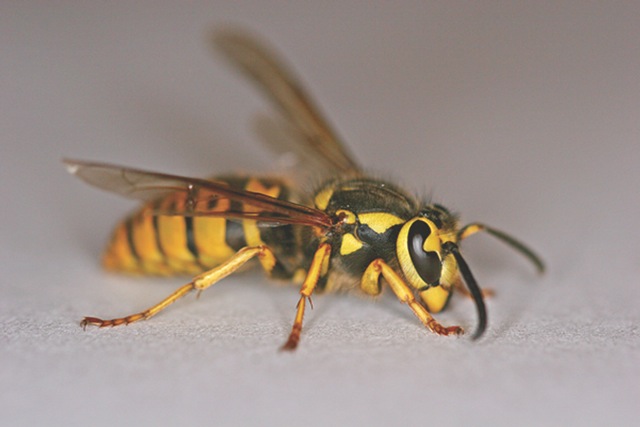FALL YELLOW JACKETS

By Stephanie Hughes
OSU Extension Volunteer Naturalist
Many people call these bees, but in fact they are not bees. It is a completely different family — and more importantly, a completely different diet which they eat.
We have seen them starting around Labor Day at picnics, the fair around the garbage cans, and even in the garden. They are attracted to rotting fruit, meat and sweets, especially in the fall. They crave sugar as winter approaches, because their normal diet of proteins reduces as winter approaches. The cycle is simple: the fertile queen overwinters, and in the spring begins to build a paper-celled nest. She hatches out 2,000-4,000 female workers that tend to her every whim. As the eggs hatch, they busily care for the offspring, as the family expands to up to 15,000! Only the female (the vast majority) sting, and with a smooth stinger, they can sting, as well as bite, repeatedly. They can even shoot venom into the eyes when defending their nest.
In the ground, they move into rodent holes, or even little holes left by a fence post. They can chew the soil mixed with saliva to make the nest larger. Nests made of paper are of chewed wood.
Yellow jackets are important pollinators and are beneficial in that they hunt and eat many harmful insects. They travel up to a mile from the nest. Traps can catch some of them, but the sure way to try to eradicate them is at night (just before the sunrise), in protective gear using an approved chemical dust shot into the hole or nest site, “immediately followed by a shovel full of moist soil.” Yellow jackets cannot see red, so a red filter on the flashlight is advised, as they will come to the light. As they groom, the insects eat the poison and die, or carry it to others. You should not plug the hole or entry site, as they can chew out (into the home). They are most aggressive around the nest site, and care must be taken, as these predators account for more than half of all human insect stings/bites. They are also drawn to perfumes and bright colored clothing.
Avoid squashing yellow jackets, as they release a pheromone that alerts other yellow jackets to your location. If you get stung, our experts suggest using an ice pack for 10 minute increments until swelling is reduced. Seek medical attention if you have been stung more than 10 times.
Only the new queen survives the winter.
As with any insecticide, read and follow all labels carefully. To learn more about yellow jackets, go to: http://go.osu.edu/jackets.
 43
43

